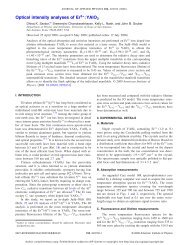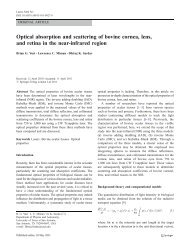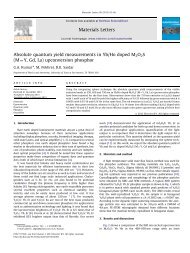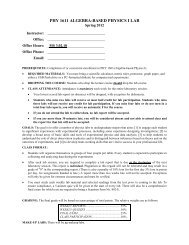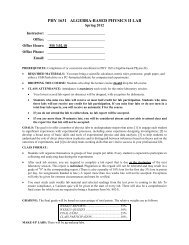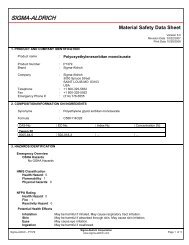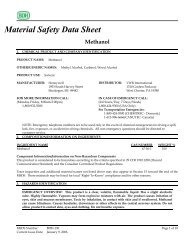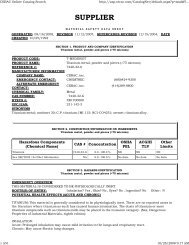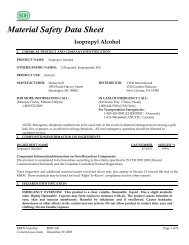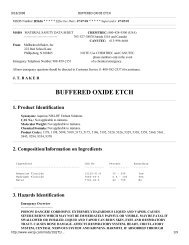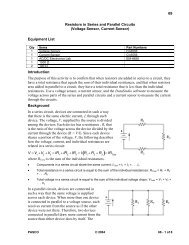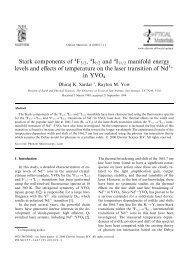Optical characterization of Er3+and Yb3+ co-doped barium ...
Optical characterization of Er3+and Yb3+ co-doped barium ...
Optical characterization of Er3+and Yb3+ co-doped barium ...
You also want an ePaper? Increase the reach of your titles
YUMPU automatically turns print PDFs into web optimized ePapers that Google loves.
1914<br />
Table 3<br />
Fluorescence lifetime (tf), emission cross-section (se), and full width at half max (FWHM) for the emission at 1571 nm in tellurite glass with different <strong>co</strong>mpositions.<br />
Sample (mol%) t f (ms) s e (10 21 cm 2 ) FWHM (nm) s e FWHM (10 28 cm 3 )<br />
80TeO2þ 15(BaF2þBaO)þ3La2O3þ1Er2O3þ1Yb2O3 a<br />
2.693 6.82 91 621<br />
75TeO2þ20ZnOþ5Na2Oþ0.5Er2O3þ1Yb2O3[21] 3.15 8.8 56 493<br />
70TeO2þ20ZnOþ5Li2Oþ5La2O3þ0.5Er2O3þ0.5Yb2O3[27] 4.02 8.5 65 553<br />
70TeO2þ10ZnOþ5BaF2þ15PbCl2þ0.5Er2O3þ1Yb2O3[17] 4.16 8.15 52 424<br />
70TeO2þ5BaF2þ10ZnBr2þ15PbF2þ0.5Er2O3þ1Yb2O3[17] 4.05 8.3 56 465<br />
70TeO2þ5BaF2þ10ZnBr2þ15PbCl2þ0.5Er2O3þ1Yb2O3[17] 3.85 8.45 55 465<br />
75TeO2þ15WO3þ10La2O3þ1Er2O3þ5Yb2O3[33] 3.0 10 77 770<br />
65TeO2þ15B2O3þ20SiO2 þ0.5Er2O3þ2.5Yb2O3[37] 2.38 7.49 71 532<br />
70TeO2þ20ZnOþ10PbOþ1Er2O3þ5Yb2O3[34] 2.69 8.77 72 631<br />
a Sample under study.<br />
Table 4<br />
Fluorescence lifetime (t f), emission cross-section (s e), and full width at half max (FWHM) for the emission at 1571 nm in different<br />
glasses.<br />
Glass type t f (ms) s e (10 21 cm 2 ) FWHM (nm) s e FWHM (10 28 cm 3 ) s e t f (10 23 cm 2 s)<br />
Tellurite [21] 3.15 8.8 56 493 2.77<br />
Silicate [36] 3.81 5.5 40 220 2.09<br />
Bismuth [38] 4.5 8.5 75 637 3.82<br />
Germanate [35] 9.55 5.7 53 302 5.44<br />
Oxyfluoride silicate [39] 9.4 7.4 60 444 6.95<br />
((Ba,La)-tellurite) a<br />
2.693 6.82 91 621 1.84<br />
a Sample under study.<br />
power. A higher excited state population with high emission cross<br />
section enables to achieve high optical gain. Thus in the design <strong>of</strong><br />
high gain amplifiers the product <strong>of</strong> emission cross section and<br />
excited state lifetime (s et) is very important and is found to be<br />
threshold pump power [40,41], The set value obtained for the<br />
present glass <strong>co</strong>mposition is listed in Table 4 along with other<br />
glass <strong>co</strong>mpositions, indicating that high gain <strong>co</strong>uld be achieved in<br />
the present glass.<br />
In analyzing the amplifier performance for broadband applications<br />
gain cross section is an important parameter. By measuring<br />
the absorption and emission cross sections using standard procedure<br />
[11] one can simulate the gain spectrum using the<br />
expression<br />
sg ¼ Nse ð1 NÞsa, ð3Þ<br />
where sa is the absorption cross section, se is the emission cross<br />
section and N is the fractional population inversion in the<br />
emitting level. The calculated gain spectra for different population<br />
inversions shown in Fig. 6 indicate that the gain increases with<br />
the population inversion and positive gain in the system can be<br />
achieved only for a population inversion <strong>of</strong> 20% and above. It is<br />
interesting to notice from Fig. 6 that even for a 20% <strong>of</strong> population<br />
a flat gain was observed in the L-band side and further increase in<br />
the population 50–60% a better gain was observed both in the S<br />
and L band regions. Moreover, the obtained gain spectrum spread<br />
from 1440 nm to 1650 nm with a spectral width <strong>of</strong> over 210 nm.<br />
3.4. Non-radiative processes and internal quantum yield<br />
A quantitative way <strong>of</strong> measuring the internal quantum yield<br />
for a particular emission band is done through the fluorescence<br />
lifetime measurements. Non-radiative processes such as multiphonon<br />
relaxation, vibrational losses by hydroxyl and other<br />
functional groups and energy transfer interaction quench the<br />
fluorescence intensity and the efficiency. The observed lifetime<br />
M. Pokhrel et al. / Journal <strong>of</strong> Luminescence 132 (2012) 1910–1916<br />
Gain <strong>co</strong>rss section, σ g (10 -20 cm 2 )<br />
0.5<br />
0.0<br />
-0.5<br />
1450 1500 1550 1600 1650<br />
Wavelength (nm)<br />
<strong>of</strong> the emission can be written as [42]<br />
Ν =0<br />
Ν =10<br />
Ν =20<br />
Ν =30<br />
Ν =40<br />
Ν =50<br />
Ν =60<br />
Ν =70<br />
Ν =80<br />
Ν =90<br />
Ν =100<br />
Fig. 6. Gain cross section spectrum for the 4 I13/2- 4 I15/2 transition showing the<br />
possible spectral width and peak gain cross section. The spectrum was simulated<br />
for different population inversion P.<br />
1<br />
¼ AradþWmp þWOH þWET, ð4Þ<br />
tlum where A rad, W mp, W HO, W ET are the radiative transition rate,<br />
transition rate from multiphonon relaxation, hydroxyl groups<br />
and energy transfer interactions, respectively. The <strong>co</strong>ntribution<br />
to non-radiative decay <strong>co</strong>mes from multiphonon relaxation from<br />
the host and energy transfer interaction between nearby ions. The<br />
transition probability by energy transfer depends on the distance<br />
between the donor (D) and acceptor (A) ions, R DA, and hence<br />
depends on the <strong>co</strong>ncentration <strong>of</strong> the ions. When the ions are<br />
homogeneously distributed in the matrix, the energy transfer




